Fourteen years ago I started doing something totally out of character, I began riding horses. Four years later I bought the horse who had been teaching me to ride, Baghera de Beaupré, a beautiful dark bay, Selle Français mare.
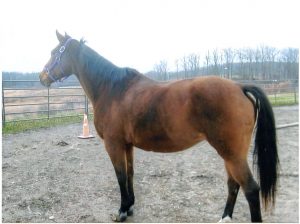
Two weeks ago I had to euthanize my 28-year-old companion to release her from the severe pain of colic for which nothing further could be done. Despite the heartbreak (anyone who has lost a close equine friend knows how devastating that death can be), I treasure the time we had together. Baghera was smart, gentle, and patient, especially with her inexperienced rider. She took good care of me and taught me so much. If I have one regret it is this: I never got that tattoo.
Didn’t see that coming, did you? As it happens, there was a time when I decided I should indulge myself in a tattoo honoring my partnership with Baghera and my new obsession with horses. I had decided on the image of the four horses’ heads from the Chauvet Cave, paintings dating back over 30,000 years, to go on my right shoulder blade. Although these paintings were not part of my purview as a medievalist, they were very familiar to me from my years teaching my program’s introductory survey of art. From the first time I saw them I was stunned by their beauty and their lifelike quality. I had seen all the attitudes on display on that cave wall in my own horse: head tucked, head craned forward to sniff out treats; ears forward and back. The Chauvet artists knew their horses. It would have made a fabulous tattoo, but I never got around to getting it done and now I wonder if I should.
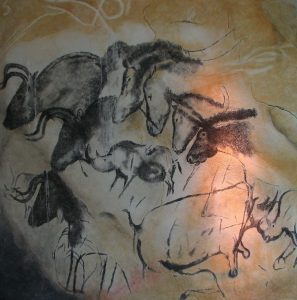
Paleolithic painted horses were not the only renderings of equines to capture my imagination in my years with Baghera. Long before I knew her, I had been enthralled with the Bayeux Embroidery; now I was doubly entranced by the textile’s incredible narrative display and its horses. Stallions, geldings, mares, they are all there, curious, brave, proud, and yes, dying. Of all the horses pictured on that 230- foot-long strip, the one that most captures my heart is the one of first horses you see, the proud stallion carrying Harold, Earl of Kent, to Bosham, the first step in his fateful journey to Normandy. This high-stepping steed with arched neck and tucked head emblematizes the status and pride of his rider sitting so erect, his head high, his left hand holding aloft his hawk. Perhaps it is this image I should imprint on my skin.
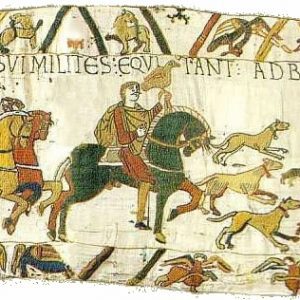
But still I hesitate, for I am not sure that I am entitled to a tattoo now that my horse is gone. Tattoos can signify a number of things including one’s individuality or rememberance of someone or some event of importance to the tatoo wearer. To me at the time, a horse tattoo signified belonging to something; it would have meant my membership in that large, diverse group of those with equine companions. Those who spend inordinate amounts of time and money seeing to the needs of these large, beautiful creatures. Those who worry over injuries and illnesses, real or imagined. Those who always smell faintly of horse sweat and manure, repulsive to some but the loveliest fragrance ever to us. But I am no longer part of this clan, I have no equine friend to fret over. I no longer belong. To claim membership through a tattoo would be to lie.
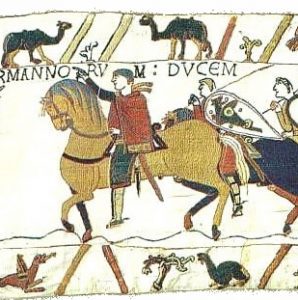
Perhaps this is also why I now focus on Harold riding off instead of William in one of the several depictions of him on his horse; after all, William won. But a victorious William is far less compelling to me than a defeated Harold. The Conqueror is never caught in a moment of doubt or confusion; he has one goal, the throne of England, and he never wavers. Harold vacillates: in one scene proud noble riding out with hawk and hounds, in another humiliated captive, forced to come to terms with both his kidnapper and his rescuer, and with his own eye on the throne. And that is why his figure in the embroidery speaks to me; he is complicated, suffering ups and downs like anyone. And, ultimately, he loses—his kingdom, his identity, his life. A journey that starts off on horseback so high-spirited, so confident ends in dismemberment, death, and no horse.
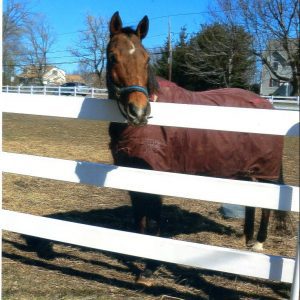
I, too, have lost. My journey with Baghera began with my first tentative and hopeful lessons as I learned the fundamentals of staying on and steering as she walked, trotted, and cantered with me. I gained knowledge of her needs both physical and psychological. I learned to treat wounds, abscesses, scratched corneas, Lyme disease, arthritis. I gained and lost confidence on a regular basis, each phase bringing me closer to her. But in the end with all that experience I could not save Baghera, so I lost my companion, and a part of myself. Unlike Harold, however, I am still here, and still able to recall the wonderful years I had with my four-legged friend. I can still groom my friends’ horses and distribute treats. I can still ride, even if not with my partner, and spend hours watching horse videos. I am not a horse owner any longer, but I am still a horse lover and always will be. So, perhaps I should get that tattoo after all.
